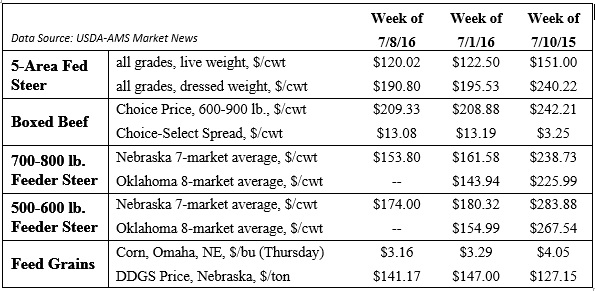In The Cattle Markets: Summer Plods Along
We are three weeks and a day into summer and the prior week was not so eventful for cattle and beef markets. There continues to be a mix of bullish and bearish news to consider. So what do the fundamentals and technical say?
Marketings and slaughter continue to be strong over the spring and summer. These volumes are solidly above last year. And the most important details from last month’s USDA Cattle on Feed report communicate that market-ready inventories continue to be drawn down from the excessive levels established since last fall. It has taken roughly a year for the market to work its way through this wreck. It takes strong marketings, light placements, and solid downstream margins for these situations to get cleaned up. All but the lighter placements have played out this spring and summer. Demand has also been solid. Beef prices have held strong in the face of stronger than prior year slaughter and meat supplies. The Choice-Select spread has returned to more normal but also solid levels. The prior week was $13-$14 per cwt – which is still strong – while the three weeks prior were above $20. Hide and offal values have held steady the last month and the most recent trade data for May – released last week – show beef meat product exports up 15% over the prior year. Thus, there is good evidence that domestic and international demands are strong. But late summer and early fall is the critical time wrecks usually start and this time period is some weeks off.
Of course, all this bullish news is in the face of very large wheat pasture feeder cattle placements, heavy cattle on feed inventories, and finally the seasonal increase in live animal slaughter weights. These prospective supply increases will weigh heavy on the market for the rest of the summer and into the fall. There is no way around these eventual heavier supplies of beef. All live cattle contracts are priced at $8-$11 discounts to the current cash market. This weak basis has persisted through much of the year. The futures are communicating a very pessimistic outlook and while the cash market has weakened cash prices have been persistently better than futures implied.
Technically, most of the live cattle contracts have been at support planes while feeder cattle have rallied to resistance planes. This suggests fed cattle were unlikely to move lower while feeders are unlikely to move higher. However, with the sharp move down Monday 7/11 some live cattle support planes were broken and this is what has to happen for the market to move lower. There was weak follow through Tuesday but breaking support remains a bearish signal. All of these markets have rallied to resistance and fallen to support repeatedly through the spring and summer. Feeders have moved down more when harvest corn futures were well above $4 per bushel. But until there is some substantially different fundament news then it looks like this is the where the markets are stuck: an oscillating pattern producing volatility with a drift lower. Further, the grain markets have reminded us of markets can do in short periods. Corn contracts are trading almost $1 per bushel lower than three weeks ago. It is also at support but the consolidation pattern shaping up suggests additional down moves are possible. Witness the sharp moves down in KC hard red wheat contracts. With harvest in full swing that market crashed support and moved into the middle-$3s. Cash wheat some locations in Colorado are trading below $3.00 per bushel. Sharp down moves in both cash and futures markets and very weak basis.
Is what is happening with hard wheat a concern for corn and cattle markets?
The Markets
The five-area fed steer price ended the week averaging $120.02 for live sales, and $190.80 for dressed; respectively, down $2.48 and down $4.73. Nebraska feeder cattle were trading almost $8 lower on the week with 700-800 pound steers averaging $153.80. Corn was $0.13 lower on the week trading at $3.16 per bushel in Omaha.








